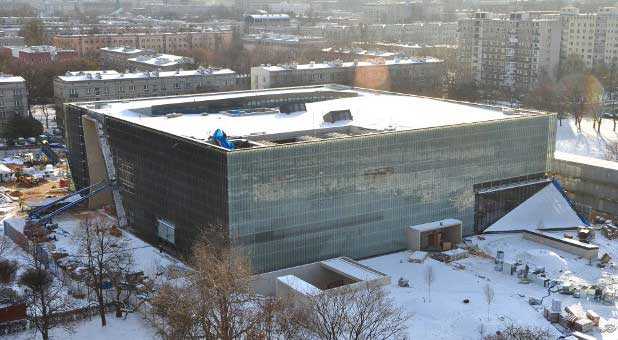A new museum of Jewish history opens in Poland this week to refocus attention on a vibrant community that has lived in the country for centuries but whose history, for many, has been eclipsed by the Nazi death camps that nearly wiped them out.
Every year some 1.5 million people visit Auschwitz, the Nazi death camp in southern Poland that has become a grisly emblem of the holocaust.
Yet in the Polish capital there is little evidence of what was for generations one of Europe’s biggest Jewish communities—just a couple of memorials down quiet streets, and a synagogue tucked away in a court-yard behind Communist-built high-rise apartment blocks.
The Museum of the History of Polish Jews in Warsaw will try to educate people about the community’s rich past, and, say its curators, might also help dispel some of the suspicion towards Jews that still now—seven decades after the Holocaust—lingers in parts of Polish society.
“I want this museum to be a museum of life, not a museum of death,” said Andrzej Cudak, acting head of the museum.
The museum, the first of its kind in Poland, is on a street that used to be part of the Warsaw ghetto. At the front, the building’s undulating walls split apart, to symbolise the rupture of the holocaust.
It opens its doors on Friday, 70 years to the day since groups of young Jews in the ghetto, with scavenged or improvised weapons, launched an uprising against German troops. It was crushed about a month later.
For now the museum will have only temporary exhibits, but once it is fully up and running next year, it will house artifacts chronicling the 1,000-year history of Jews in Poland.
“This is not going to be another holocaust-type museum,” said Robert Supel, a project director at the museum.
One of the eight galleries will be devoted to the holocaust, he said, “but primarily we are talking about life, we are talking about culture, we are talking about the exchange of influence of nations, we are talking about all aspects of Jewish life in Poland since the early medieval period.”
Low-Key Community
Before World War II, more than three million Jews lived in Poland. By the end of it, 90 percent of them were dead.
The museum will become the most visible symbol in Warsaw of a Jewish presence that is strikingly low-key.
Other eastern European capitals where Jews were exterminated have seen a limited revival of their Jewish communities since the end of Communist rule two decades ago.
But only 7,500 Jews live in Poland, according to a census conducted in 2011, though the real figure is probably higher. In the capital, there are few synagogues left. It is rare to see anyone in the street wearing a yarmulke or the fedora of an orthodox Jew.
Anti-Semitic attitudes could be part of the reason for this low profile. There is no anti-Semitism in public life in Poland, unlike nearby Hungary where one far-right member of parliament last year called for lists of Jews to be compiled. The Polish government helped pay for the museum.
Nevertheless, low-level anti-Semitism is present, from soccer chants where fans use the term “Jew” as an insult hurled at rival supporters, to the graffiti on suburban walls.
A poll conducted last month by the Homo Homini public opinion institute found that half of Warsaw high-school students would be unhappy if they discovered someone in their family had Jewish origins. Sixty percent of young people would be displeased if their boyfriend or girlfriend turned out to be Jewish, according to the survey.
The poll was commissioned by the Jewish Community of Warsaw, one of the country’s biggest Jewish groups. Its head, Piotr Kadlcik, said he hoped the new museum would shine an objective light on how Poles and Jews have co-existed through history.
“Let’s not think that the museum will be a panacea for all the problems we have with Polish-Jewish relations,” Kadlcik said. “But if it helps just in part, that will be a success.”
(Additional reporting by Piot Pilat and Marcin Goettig; Editing by Christian Lowe)
© 2013 Thomson Reuters. All rights reserved.














































